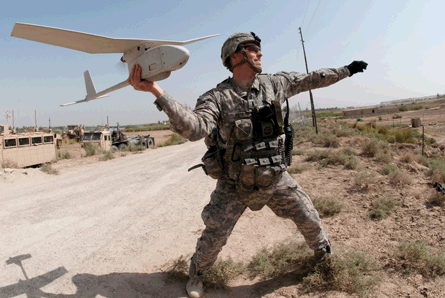AeroVironment may have topped expectations for fourth quarter earnings in its year to 30 April, but the California-based unmanned aerial systems maker's predictions for the current year came in below analyst projections. The company's next steps remain unclear in an increasingly competitive market.
In a storming fourth quarter, unmanned systems segment gross margin jumped 88% year-on-year to $39.2 million on revenue up 40% to $92.1 million. For the full year, segment profit was up by a fifth to $85.2 million as revenue grew 6% to $224.2 million.
Chief financial officer Jikun Kim says revenue was up mostly from deliveries of the new, digital version of the Raven hand-launched surveillance aircraft and retrofitting four-channel analogue Raven RQ-11B systems with digital datalinks. The gains offset declining volume.
 |
|---|
© USAFNevermore: Raven rules, but sales growth is unsustainable |
DOMINANT ERA
A fall-off in deliveries is no surprise. AeroVironment has dominated the market for small, handheld systems in recent years. But as it notes in its year-end filing, rivals are on the march and, it adds, "some of these contractors have significantly more financial and other resources than we possess".
More than 13,000 Raven systems have been delivered so far, including thousands to the US Army, since the 1.37m (4.5ft)wingspan, 1.9kg (4.2lb) hand-held, remote controlled spyplane was first deployed in 2004. The air service also operates more than 1,000 twin-camera Wasp systems for beyond-line-of-sight situational awareness.
US Marines have been operating the 2.25kg RQ-14 Dragon Eye, which launches with an off-the-shelf bungee cord, since 2003.
The company enjoys a robust sustainment business and expects the small UAS market to continue to evolve, but its early 2000s growth rate is unsustainable.
The lightweight, GPS-navigated Puma AE, with a 15km (8.1nm) range and 2h maximum flight time, could be the answer for a forthcoming US Army requirement for an unmanned system to occupy the space between the tiny Raven and relatively huge ScanEagle from Boeing InSitu. US Special Operations Command bought Puma in 2008.
But for the most part, AeroVironment is now working to find a new niche in the already-niche unmanned market - and competing against the world's largest defence contractors to do it.
BIGGER AND HIGHER
For that next growth phase, AeroVironment is looking to the high-altitude, long-endurance (HALE) UAS market with Global Observer. Designed to fly at 55,000-65,000ft for five days or a week at a time, Global Observer could fill the near-space surveillance desires of the USA and other militaries, serving in some situations as a satellite alternative.
Chief executive Tim Conver says Global Observer could be "transformational" for AeroVironment if it goes to production. "It is designed to have significantly lower operating costs than conventional airplanes, due to its far fewer landings and greater efficiency. Relative to satellites, it will have the advantage of repositioning, while accommodating payload repairs and upgrades, in addition to lower costs," he says.
But getting into the HALE market will mean competing for the first time with large aerospace and defence companies such as Aurora Flight Sciences, Boeing, Lockheed Martin, Northrop Grumman and Qinetiq.
SMALL BUT DEADLY
In documents accompanying its quarterly filing, AeroVironment also points out a possible void in the market for easy-to-launch armed unmanned system. "An established market for man-portable, high-precision loitering miniature airborne munitions systems does not exist," it says.
It adds: "The successful introduction of our Switchblade system could establish this market, and if so, would likely attract potential competitors that could range from large aerospace and defence prime contractors to smaller, more innovative technology developers."
Before taking on that hurdle, the company has a more immediate one to clear.
AeroVironment's billing practices are under investigation by the Civil Fraud Section of the US Justice Department. The investigation is examining the company's billing labour rates for time and materials on government contracts, billing rates for maintenance and repair contracts and whether its fiscal year 2006 expense claims were appropriate.
Source: Flight International



















